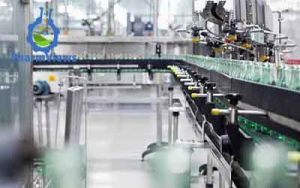The pharmaceutical industry typically uses liquid filling machines for numerous reasons. Through nozzles, bottles and other containers are filled with liquid as they move along a conveyor belt.
These machines are available in various models, each with a unique mechanism. They come in manual, semi-automatic, and fully automatic varieties.
Automatic liquid bottle-filling equipment is now more productive and long-lasting thanks to advancements in technology. It is suitable for a variety of bottles because of its variable speed and height-adjustable nozzles.
The significance of liquid filling devices in the pharmaceutical industry
When liquids need to be packed in various types of containers in the pharmaceutical industry, liquid fillers, also known as liquid filling machines, are crucial pieces of equipment.
With the aid of liquid filling machines, liquids can be quickly and effectively packed into containers without wasting much.
Imagine if this process had to be carried out by hand. How much liquid would be wasted because of spills, and how long would it take to carry out such bulk packing applications? So, liquid filling devices are employed.
The best machines for packing liquids in industries quickly and efficiently are the modern liquid filling machines, which are available in cutting-edge designs with user-friendly controls and features.
A liquid filling machine can quickly and easily complete the enormous liquid filling tasks in the the pharmaceutical industry; as a result, it can replace the work of many people who would have been required to complete the process in the absence of these machines.
It is frequently used to fill containers with liquids like syrup, oil, wine, and other substances with high viscosities.
A very efficient way to fill such liquids into the appropriate containers is with the liquid filler. Due to gravity, the filling device fills the liquid.
Due to their own weight, the liquid fills the bottle to the desired level. Tanks, bottles, or other containers can be integrated into the machine to fill liquids.
Advantages of the liquid filling machine
Listed below are a number of advantages of the liquid filling machine:
It is possible to avoid measuring instruments, which would result in time loss, and inconsistencies when bottling, which makes shipping simpler.
By using measurements of volume, weight, level, and other inputs, liquid filling equipment makes sure that each bottle is filled with an equal quantity of the product.
Rotative fillers and machines with capers are very simple and quick operating systems. Filling machines are very adaptable because they have input settings for indexing times, fill times, and pump speeds.
These devices can fill both thick and thin liquids, which is advantageous for companies with multiple production lines looking for more lucrative business opportunities.
Most industrial filling machines start out with four to six filling heads, depending on the model. It is a very scalable option because this can be increased over time and some models even have a maximum of sixteen fill heads.
How to Purchase Liquid Filling machines for Large-Scale Applications
When purchasing a liquid filler for your business, there are many factors to take into account. The decision of whether to choose a semi-automatic or fully automatic filler is entirely up to the buyer.
These are capable of bulk filling tasks and may even be able to meet a comprehensive need from filling to capping.

It is possible to request various customizations, which manufacturers skillfully design along with various attachments.
However, the following important factors should be taken into account when purchasing a liquid filler:
- Following-Sale Service, Time Guarantee, and Process Execution
- flexibility in working with various bottle types
- ability to adjust the liquid’s various volumes.
- Cost-Effectiveness
- newest research and technology
The most crucial factor in obtaining the most advanced and best machinery with the desired specifications and at profitable prices is choosing the best seller.
Types of liquid filling machines in the pharmaceutical industry
See below;
Electronic Liquid Filling Device
The semi-automatic digital liquid filling machine is used to precisely fill liquid into bottles and other containers. The gear pump filling principle underlies how these devices operate. It is a small device with a silicon pipe attached.
These devices are simple to use and consume little power. These digital liquid filling machines can fill 100 to 500 bottles per hour and are suitable for all types of liquids with different densities.
While bottles are filled from the front, the tank is attached at the back. The digital keypad is used to punch in the amount of liquid that needs to be added and the amount of time between each bottle.
Digital (Electronic) Automatic Liquid Filling Machine
In order to store sterilized liquid products, particularly medications, in previously sterilized containers under sterilizing circumstances, aseptic filling machines are used.
In order for the product to be shelf-stable and not require refrigeration, this process requires a clean and contamination-free environment.
The lined and stacked tubes are ready for filling. Then a nozzle fills each one individually. Almost immediately after the tubes have been filled, a stopper is pushed onto the container’s mouth. By doing this, it ensures that no outside particles enter.
Aesthetic filling devices
A volumetric filling machine that can fill a variety of viscous fluids is the servo-based linear piston filling machine.
These machines can be customized to have as many filling nozzles as you need, such as 6, 8, 10, 12, or 16. A servo motor and piston system power it.
Through a digital panel, it is simple to use. Additionally, the digital panel assists in applying force of varying strength. The accuracy rate of this servo-based piston filling machine is high.
Linear piston filling machine with servo technology
An auto manual machine is one that fills with a single head piston. For thick, foamy liquids like liquid hand soap, this machine is more appropriate.
The piston is the main component in charge of drawing liquid from the tank and pushing it toward the nozzle, which fills the containers. On various components of the machine, there are numerous valves that regulate the direction and flow of liquid.
Single Head Piston Filling Semi-Automatic Machine
The bottle filling machine for Monoblock is fully automatic. In this instance, the capping and sealing device is affixed to the filling device.
It is best to use this machine for bottles that are round or oval in shape. Its production capacity is influenced by a number of variables, including the type of liquids used, bottle height, bottle diameter, etc. It uses a rotating bottle system to operate.
The volume of the liquid that needs to be filled and can be changed easily without changing any part of the machine thanks to flow meter technology.
Because it is small, it can operate more effectively without taking up much space, in contrast to traditional inline systems. This machine is completely self-sustaining and does not require ongoing human supervision.
Features of liquid filling machines in the pharmaceutical industry
- FILLING APPARATUSES
Pharmaceuticals will likely use sanitary filling equipment more than any other industry, with the possible exception of the food and beverage industry.
Given that both of these industries produce goods intended for human consumption that will be ingested, this is not surprising.
Pharmaceutical filling equipment uses sanitary fittings to prevent product contamination as it moves through the equipment, along the product pathway, and into bottles or other containers.
Sanitary fittings and plumbing offer a smooth surface that reduces product buildup, facilitates cleaning, and guards against leaks and external contamination.
Because it won’t rust or corrode with most products, stainless steel is a popular material for sanitary filling machines, but other materials can be used as well.
- GLASS CLEANING
As mentioned, there are some additional features that are fairly typical to these packaging systems even though the filling machine will be especially made for pharmaceutical products.
There will be some sort of container cleaning machine in almost every pharmaceutical line. Before the product is introduced, these machines will clean the inside of the bottle with some sort of rinse media, such as air, water, or another liquid.
To prevent product contamination, bottle rinsers and washers will remove dust, debris, and other buildup from inside the bottle. To ensure a clean, hygienic container, some lines will even use a bottle vacuum in addition to the air rinse.
- CAPTURE TECHNIQUES
Spindle cappers, snap cappers, and chuck capping machines are common examples of capping machinery used for pharmaceutical products.
However, capping equipment for these lines frequently has extra parts or capabilities. Many of these items will have child-resistant caps and other tamper-evident seals to keep them sealed.
Bottles and containers can be sealed to make them safe and tamper-evident with the aid of packaging machinery like induction sealers, neck banders, and similar tools.
These are some of the more typical features found in liquid filling machines and other pharmaceutical equipment, but new technology will inevitably bring about new developments and features on packaging machines.
Editor’s Picks
Tablet compression machine; facts Functions, benefits, parts 2023
